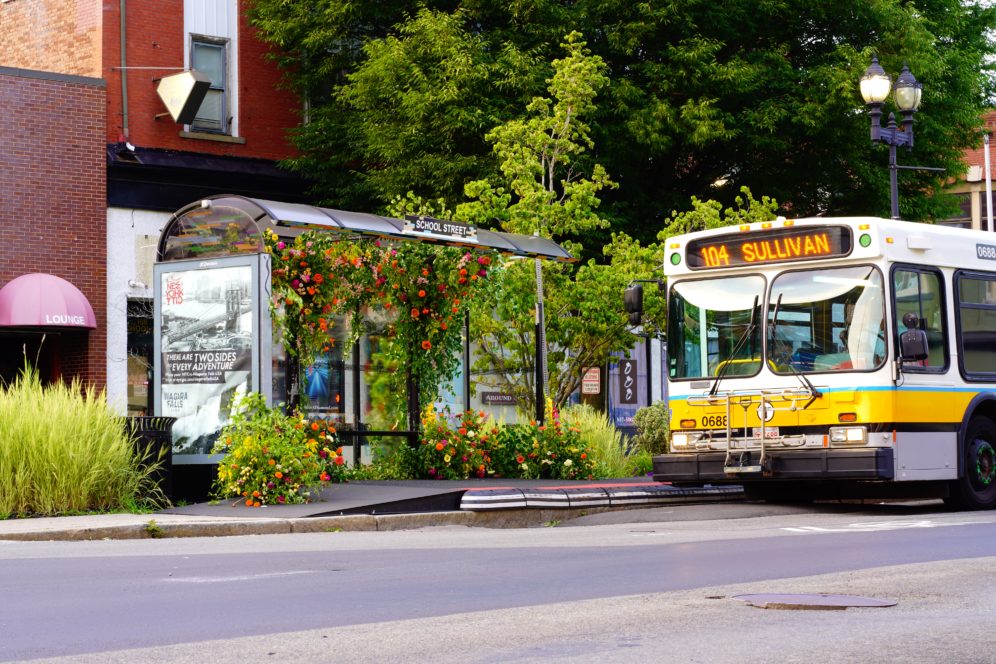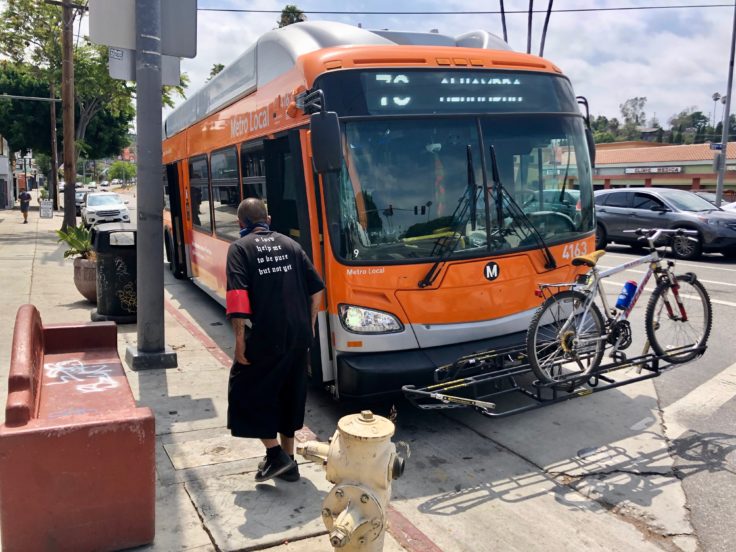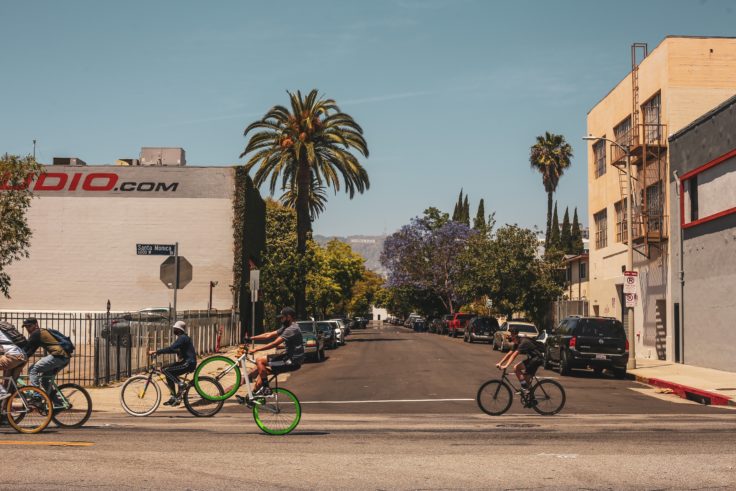
April 21, 2022
From the Golden Coast to the Bay State: U.S. Cities on the Move
ITDP recently interviewed two of its U.S. Program team members to get their perspectives on the challenges and opportunities facing their regions when it comes to advancing more sustainable and equitable cities.
Carolynn Johnson is ITDP’s West Coast Program Manager based in Southern California and leads the organization’s research, engagement and advocacy projects in the region. Julia Wallerce is ITDP’s Boston Program Manager, leading initiatives such as BostonBRT to bring true bus rapid transit to the Boston area.
ITDP: What is an urgent need in your region for advancing sustainable and equitable transportation?
Carolynn: One that stands out for us in LA and impacts every aspect of our transportation system is revenue funding.
Julia: Yes, public transit needs to be adequately funded like the essential service it is rather than one that fluctuates as a result of ridership or the market. Cutting service when ridership is down is not the answer. You don’t start tearing up roads because people aren’t driving cars on them, or turning off electricity to buildings where fewer people are going to work. Ultimately, we need to expand and maintain service and decrease our reliance on fare revenue by securing long term, sustainable revenue sources.

ITDP: What sort of strategies are working in LA and Boston to foster inclusive transit planning?
Carolynn: We’re excited to have LA as a main cohort city in our Cycling Cities Campaign. Planners and advocates in Los Angeles don’t often connect with the model cycling cities like Copenhagen or Amsterdam which are 50 or more years ahead. Through our Cycling Cities campaign they are joined with major cities throughout the Global South like Jakarta, Rio de Janeiro, Mexico City, and Bogota. They see themselves facing the same challenges around sprawl, rapid development, and inequality. Our LA partners are excited to learn about their solutions.
Julia: We found a lot of success when we formed a partnership with the Everett Haitian Community Center, which represents over 20,000 Haitian residents, and provided grant funding to support their engagement in a bus priority and street improvement pilot. That partnership dramatically increased our reach in the community — we were able to incorporate feedback from 400 people in Haitian Creole, most of whom are transit dependent and not typically represented or engaged in municipal projects. That really made the work resonate in the community. We’re trying to replicate that model in the future with other community groups.
Carolynn: LA is very diverse, so solutions look different for each community. ITDP has been working with the Mayor’s Office of Los Angeles to develop a zero-emission area, which would prioritize walking, cycling, and public transit, and help shift travel toward zero-emission modes. There are a lot of ways to get to zero and we’ve embraced that creativity in our planning. The zero-emission area planning process will prioritize communities and encourage developing solutions in a collaborative way.
Julia: We work closely with a number of regional and statewide coalitions which are effective at pushing for policy change from a collective yet united body of interests. The Transit is Essential Coalition, in particular, has seen enormous success in reversing transit service cuts and influencing both the legislature and agency officials to act on fare policy. Our hope is that the City of Boston continues on its path towards bus and street transformation from an equity perspective as it effectively meets so many of our already established climate and equity goals, and ultimately makes the city a better place for everyone.
Carolynn: LA is building three BRT systems over the next 10 years. ITDP wants to make them world class systems where people have positive experiences. Supporting government agencies in working with communities to help them understand the possible positive impacts at street level is really powerful.

ITDP: Fare-free transit initiatives are being piloted in many cities. What does it take for them to be successful and how can they transform the bus experience?
Julia: We’ve seen quite a number of fare-free bus pilots launch throughout Massachusetts since 2020, including the Boston Mayor Wu’s recent announcement that three major bus routes serving the Dorchester/Mattapan neighborhoods will be fare-free for two years starting March 2022. In all of these pilots, both ridership and rider satisfaction have surged as the bus becomes a more affordable, accessible option. Of course, having a sustainable funding source to replace the fare revenue is critical, and there is no “one size fits all” solution at this point. However, a universal benefit to fare-free bus initiatives is that they also enable all-door boarding, a central element of bus rapid transit (BRT), which significantly speeds boarding times and reduces the amount of time a bus spends sitting at the station.
Carolynn: We’re part of a coalition called Better Buses for LA which focuses on improving service and bus transit experiences for the majority of bus riders in LA — low-income, people of color. LA Metro, Los Angeles County’s transit agency, was essentially fare-free throughout the pandemic while they stopped enforcing fare collection. In many ways, this multi-year policy, which ended in January 2022, was one of the longest fare-free experiments in the country. In addition to supporting communities hit the hardest by the economic and health impacts of COVID-19, it also improved bus times and reduced vehicle miles traveled in the city. I think this gives LA Metro a lot of good data to move forward with more fare-free efforts as well.

ITDP: Looking ahead, shifting the mindset around car use will be critical for reaching climate goals. How will this impact your work in public transportation?
Carolynn: LA is known as the car capital of the world, so changing that mentality is an enormous challenge. During the pandemic, there have been some promising changes with parking, especially the city-based Al Fresco program which allows restaurants to convert parking into dining spaces. The program has been successful and helped business owners see that parking reform can be beneficial. We hope this can build momentum around eliminating parking minimums which is important for more walkable and less car-oriented communities.
Julia: Contrary to LA, Boston is typically known as being a walkable city, but Boston has the worst traffic at rush hour. We’re the only American city without dynamic road pricing, so there is no incentive to drive at a different time of day to avoid congestion. The role that buses can play — not just in mitigating equity gaps and the effects of climate change but also in reducing congestion — is enormous. That’s a big reason why we and other advocates have turned to focus on buses. At the end of the day, like most things related to behavior change, dynamic road pricing and bus improvements are matters of political will.
Read more here about ITDP’s Cycling Cities for Los Angeles campaign, which aims to provide government officials, planners, advocates, and others the tools to make cycling a safe and affordable transportation option while investing more into LA neighborhoods.
